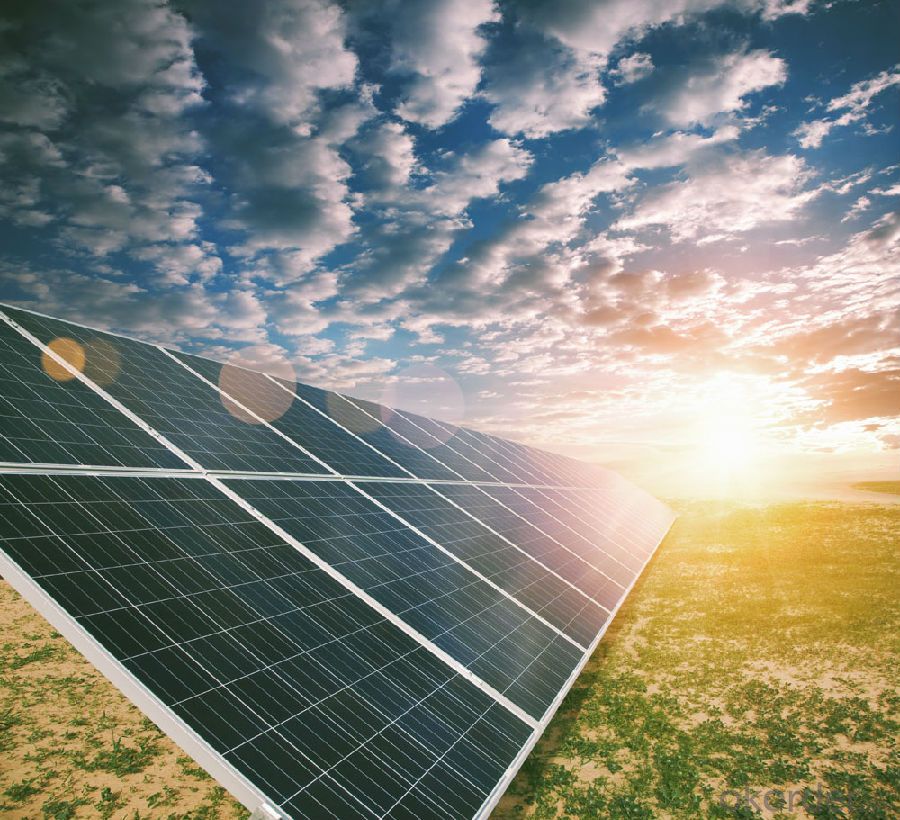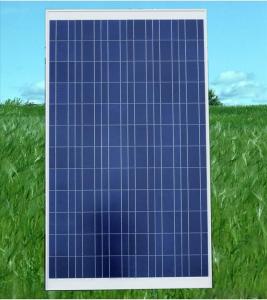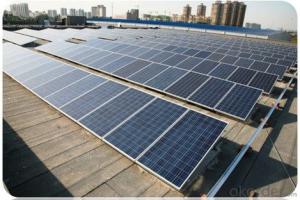Solar Panel 245w Silicon Polycrystalline
- Loading Port:
- Guangzhou
- Payment Terms:
- TT OR LC
- Min Order Qty:
- 200000 watt
- Supply Capability:
- 20000000 watt/month
OKorder Service Pledge
OKorder Financial Service
You Might Also Like
INTRODUCTION
This installation Manual contains essential information for the electrical and mechanical installation that your must know before installing CUSTOMER PV modules. This also contains safety information you need to be familiar with .All the information described in this manual are the intellectual property of CNBM and based on the technologies and experiences that have been acquired and accumulated in the long history of CUSTOMER. This document does not constitute a warranty, expressed or implied.
Our present annual capacity is 6 million for wafer, 60MWp for solar cells,200MWp for solar modules and one hundred thousand for solar applications. It is expected that the annual capacity of 2012 will be up to 30 million for wafer, 300MWp for solar cells, 1000MW for solar modules and 2 million for solar applications.
The installation of PV modules requires a great degree of skill and should only be performed by a qualified licensed professional, including licensed contractors and licensed electricians. Please be aware that there is a serious risk of various types of injury occurring during the installation including the risk of electric shock. All CUSTOMER modules are equipped with a permanently attached junction terminal box that will accept variety of wiring applications or with a special cable assembly for ease of installation, and they do not require assembly.

DATA SHEET
Maximum Power | 245W |
Efficiency | 0.151 |
Backsheet | Silver |
Frame Colar | White |
Manufacture Site | China |
Frame | Anodized Aluminum Alloy |
Weight | 19 kg |
FAQ:
Q1: Why buy Materials & Equipment from OKorder.com?
A: All products offered byOKorder.com are carefully selected from China's most reliable manufacturing enterprises. Through its ISO certifications, OKorder.com adheres to the highest standards and a commitment to supply chain safety and customer satisfaction.
Q2: What is a solar PV module?
A: A solar PV module consists of many solar cells that are connected together (typically in series) and packaged in a frame (typically made of aluminum).
Q3: What are the advantages and disadvantages of monocrystalline solar PV modules?
A: Monocrystalline solar PV modules are the most efficient type of solar PV modules, with the exception of CdTe thin film solar PV modules. As a result, monocrystalline solar PV modules are more expensive when compared to almost all other types of solar PV modules.
- Q:I am intrested in buying solar panels to save a buck and even maek some money off of it but I was wondering what kind? How Much? How Many? Are they easy to install? Whats the best brand? I want alot of information on this if anyone can give me some help on it in a user friendly way it would be appreciated!
- Guide okorder
- Q:Can solar panels be installed on a hospital or medical facility?
- Yes, solar panels can be installed on a hospital or medical facility. Solar panels can help hospitals and medical facilities reduce their electricity costs and reliance on the grid, while also promoting clean and sustainable energy.
- Q:Can solar panels be used in areas with high levels of pollution from transportation?
- Yes, solar panels can still be used in areas with high levels of pollution from transportation. While pollution can potentially reduce the efficiency of solar panels by blocking sunlight and depositing dirt or particles on their surface, advancements in technology and regular maintenance can help mitigate these effects. Additionally, installing solar panels can contribute to reducing overall pollution levels by transitioning to clean energy sources.
- Q:I jotted down some notes for my Technology and Architecture class and I'm trying to figure out what i meant when i said 'Treated with gases at extremely high temperatures.' I have NO idea what I was talking about :) Im trying to figure out if what I am talking about is about Silicon, Polychristaline, or a Solar Cell/Panel.
- Let’s start off and discuss the three main types of photovoltaic (PV) panels: Monocrystalline Solar Panels - Monocrystalline cells are cut from a block of silicon that has been grown from a single crystal.These tend to be the most efficient, but also the most expensive solar panels. They have been considered the go-to panels for the last couple decades, and also boast being the oldest and most dependable. Polycrystalline Solar Panels - Polycrystalline cells are cut from multifaceted silicon crystal. They don’t come from a single piece of silicon crystal, but rather from many different crystals. These solar panels tend to be less efficient than monocrystalline solar panels of the same size. This means a 200 Watt Monocrystalline panel will usually be smaller than a 200 Watt Polycrystalline panel. Thin Film or Amorphous Solar Panels - These panels are not made up of any crystals. They are actually a thin layer of silicon deposited on a substrate or base material like metal or glass. Thin film solar panels tend to be the least efficient per square foot, but they are also the cheapest. The best application for amorphous panels is if you have a large amount of surface area and space doesn’t matter.
- Q:Can solar panels be used in areas with high levels of radiofrequency interference?
- Yes, solar panels can be used in areas with high levels of radiofrequency interference. However, it is important to note that radiofrequency interference may affect the performance of solar panels and reduce their efficiency. Proper shielding and grounding techniques can be employed to minimize the impact of radiofrequency interference on solar panel operations.
- Q:Actually I want to convert my home electricity on Solar Panel to cut down electricity costI have 2 AC's, a refrigerator, 3 Television, 2 Computers, 4 Fans etc
- good okorder lots of good ideas there
- Q:For part of a school project how would I charge a car battery with a solar panel? The panel is 48V and 6A. This needs to be low budget so I can't buy an expensive controller, Is that the only way or are there other ways of doing it?
- 48 volts is rather uncomfortable. I would be inclined to modify the panel by cutting traces to give me a number of 5 volt sets. Most PV cells output about 700 mV, but check to see what yours does. Measure one cell, or count the number of cells and divide into the panel voltage. If you work with the 48 volt output, you are throwing 70% of the output away. The classic method of charging a lead/acid battery is to use the 0 hour rate...a 200 AH battery is charged at 20 amps. However if the charge is to be near continuous during daylight, I think I would go a little lower...say 5 amps in order to be kind to the battery. I note that your panel has a 6 amp output, so when you modify it, it should be able to deliver about 8 amps. A useful trick is to use car headlamp bulbs in series. The filament has a high positive thermal coefficient of resistance, and tends to act as a current regulator. In this case, I would use two dual filament bulbs with their filaments in parallel, arranged in series.
- Q:What are the advantages of using solar panels?
- There are several advantages of using solar panels. Firstly, solar energy is a renewable source that does not deplete natural resources, making it environmentally friendly. Additionally, solar panels produce clean energy, reducing greenhouse gas emissions and combating climate change. Solar power can also save money in the long run, as it reduces or eliminates electricity bills. Moreover, solar panels require minimal maintenance and have a long lifespan, making them a reliable and cost-effective energy solution. Finally, solar energy can provide energy independence, as it can be generated on-site, reducing reliance on traditional power grids.
- Q:Can solar panels be used in remote areas with no access to the grid?
- Yes, solar panels can be used in remote areas with no access to the grid. Since solar panels generate electricity from sunlight, they can provide a reliable and sustainable source of power in off-grid locations. By harnessing the energy of the sun, solar panels can charge batteries or directly power electrical devices, making them an ideal solution for remote areas without access to the traditional power grid.
- Q:im making an energy efficiant house for science class and i need to price the house. im putting solar pannels on the roof and would u please tell me how much they are per like 2 sq. feet of a pannel?
- Completely self-efficient and autonomous??? Forget it. Too expensive. It's only worth if you use like 8 lights (2-20w) about 4 hours a day, a fridge, a tv about 4 hours/day and basically nothing else or a few low consume stuff. Forget about microwaves, dryers, or other stuff. Too much watts. And that would cost you no less than 5000-6000$. You need panels (about 4 or 6 20w would suit maybe), 2 batteries (about 600Ah at least), inverter(500w/24v) and a regulator, lets say a 30A one. Just stick to normal energy supply. A single 20w panel may cost about 750$ at least.
1. Manufacturer Overview |
|
|---|---|
| Location | |
| Year Established | |
| Annual Output Value | |
| Main Markets | |
| Company Certifications | |
2. Manufacturer Certificates |
|
|---|---|
| a) Certification Name | |
| Range | |
| Reference | |
| Validity Period | |
3. Manufacturer Capability |
|
|---|---|
| a)Trade Capacity | |
| Nearest Port | |
| Export Percentage | |
| No.of Employees in Trade Department | |
| Language Spoken: | |
| b)Factory Information | |
| Factory Size: | |
| No. of Production Lines | |
| Contract Manufacturing | |
| Product Price Range | |
Send your message to us
Solar Panel 245w Silicon Polycrystalline
- Loading Port:
- Guangzhou
- Payment Terms:
- TT OR LC
- Min Order Qty:
- 200000 watt
- Supply Capability:
- 20000000 watt/month
OKorder Service Pledge
OKorder Financial Service
Similar products
New products
Hot products
Related keywords





























